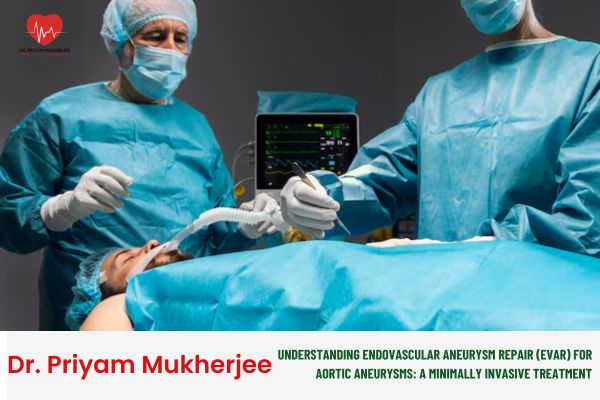Understanding Endovascular Aneurysm Repair (EVAR): A Minimally Invasive Approach to Treating Aortic Aneurysms with Dr. Priyam Mukherjee
Aortic aneurysms, which occur when the wall of the aorta weakens and bulges, pose a serious risk of rupture, leading to life-threatening consequences. Fortunately, with advances in medical technology, treatment options like Endovascular Aneurysm Repair (EVAR) have revolutionized the way we manage this condition. Dr. Priyam Mukherjee, an expert in vascular surgery, shares insights into this innovative procedure, which offers a safer, minimally invasive alternative to traditional open surgery.
What is Endovascular Aneurysm Repair (EVAR)?
Endovascular Aneurysm Repair (EVAR) is a minimally invasive technique used to treat aortic aneurysms. It involves the insertion of a stent graft into the affected area of the aorta through small incisions, typically in the groin. This stent graft strengthens the aorta and prevents the aneurysm from rupturing, offering a far less traumatic solution compared to the conventional open surgery.
How Does EVAR Work? Insights from Dr. Priyam Mukherjee
Dr. Priyam Mukherjee explains that the EVAR procedure involves several precise steps:
- Preparation: The patient is given anesthesia to ensure comfort. Small incisions are made in the groin to access the femoral arteries.
- Placement of the Stent Graft: Using real-time imaging techniques, the surgeon carefully guides the stent graft through the artery to the site of the aneurysm. The graft is then expanded to reinforce the weak section of the aorta.
- Final Adjustment and Monitoring: Once the graft is in place, Dr. Mukherjee monitors its position to ensure optimal coverage of the aneurysm. The incisions are then closed, and the patient is closely monitored for recovery.
Why Choose EVAR? The Benefits Explained by Dr. Mukherjee
Dr. Mukherjee highlights several key advantages of EVAR over traditional surgery:
- Minimally Invasive: Unlike open surgery, EVAR requires only small incisions, which results in less trauma to the body and surrounding tissues.
- Faster Recovery: Since the procedure is less invasive, patients experience a much faster recovery time, allowing them to return to daily activities in weeks rather than months.
- Reduced Complications: EVAR carries a lower risk of infection and other complications compared to open surgery.
- Less Pain: Due to the smaller incisions and minimal disruption to surrounding tissues, patients typically experience less postoperative pain.
Who is a Candidate for EVAR?
Not all aortic aneurysm patients are candidates for EVAR. Dr. Mukherjee notes that patients with large abdominal or thoracic aortic aneurysms, which can be safely accessed through the femoral arteries, are ideal candidates. Additionally, patients should be in overall good health to undergo this procedure.
What to Expect During Recovery
Dr. Mukherjee advises that recovery after EVAR is usually faster than traditional surgery. Most patients are able to go home the day after the procedure. While full recovery can take a few weeks, the majority of patients are able to return to normal activities within 1-2 months. Regular follow-up visits are essential to monitor the stent graft’s performance and ensure the aneurysm remains stable.
The Future of Aortic Aneurysm Treatment
Endovascular Aneurysm Repair continues to evolve, with improvements in stent graft technology and surgical techniques. As Dr. Priyam Mukherjee points out, EVAR offers a bright future for patients suffering from aortic aneurysms, providing a safer and more effective treatment option with less risk and quicker recovery.
Conclusion
Endovascular Aneurysm Repair (EVAR) represents a significant breakthrough in the treatment of aortic aneurysms. Under the guidance of experienced surgeons like Dr. Priyam Mukherjee, this minimally invasive procedure has helped many patients avoid the complications of traditional surgery. If you or a loved one is dealing with an aortic aneurysm, consider consulting with a vascular specialist to learn if EVAR is the right treatment for you.
